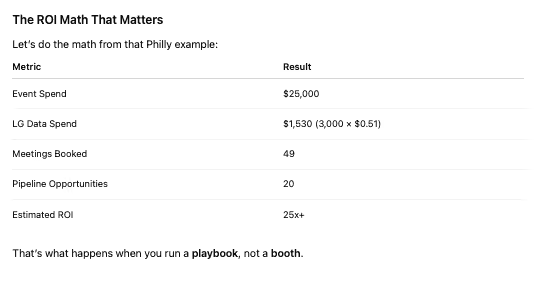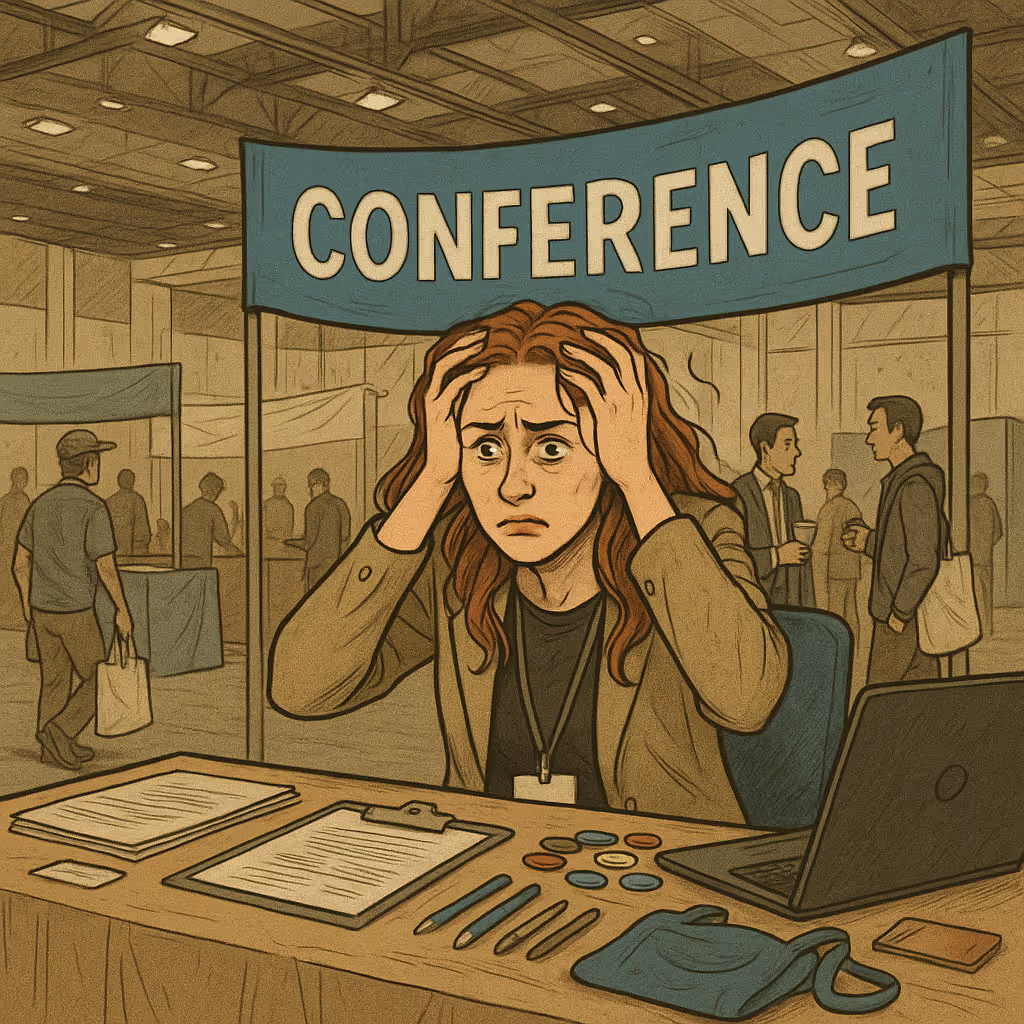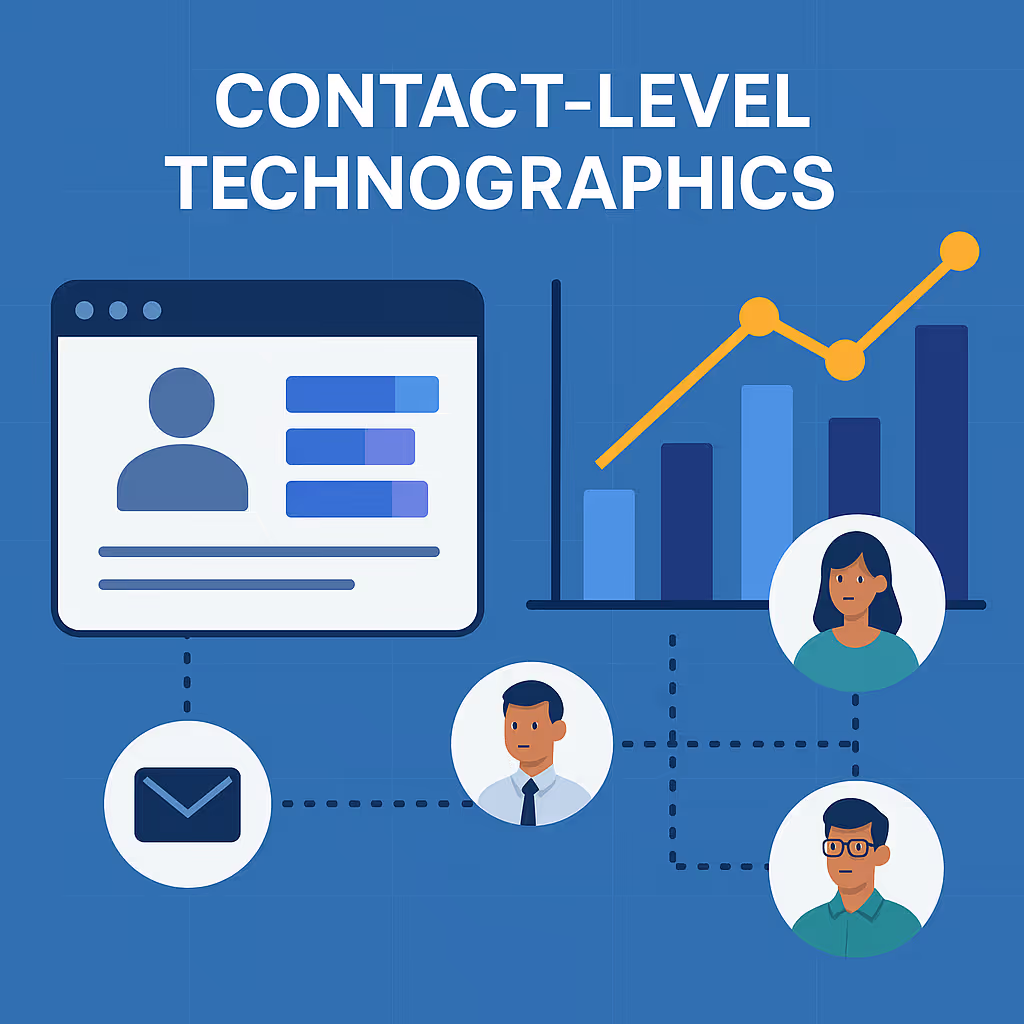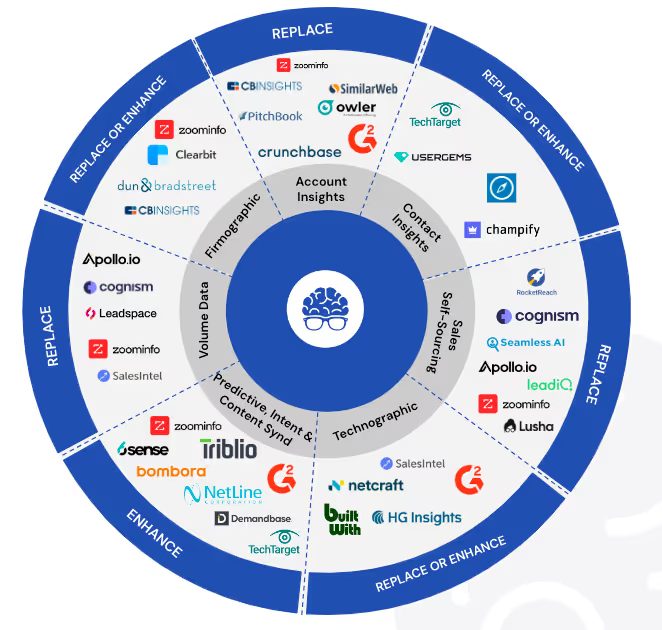Every marketer knows that feeling.
You’ve spent months prepping for the big event. The booth design is finally approved after twelve rounds of “Can we make the logo bigger?” debates. Swag has been ordered (in three colors, just to be safe). Flights, hotels, and meals are booked. The sales team is hyped.
You’ve spent $25,000—sometimes $50K+—for what everyone calls “brand presence.”
And yet… three days later, your reps are standing in the booth, awkwardly scanning badges, while competitors and swag hunters wander by in hoodies and tote bags. You collect a few hundred leads. Maybe 5% are relevant. You high-five, pack up the pop-up banner, and head home to the inevitable question:
“Was it worth it?”
Most of the time, it wasn’t.
The Harsh Truth: Events Don’t Create ROI—Preparation Does
Conferences are high-risk, high-reward GTM moments. They’re the Super Bowl of face-to-face marketing—but they can also be financial sinkholes if you treat them as isolated events instead of integrated campaigns.
That’s why the best GTM leaders don’t attend events. They engineer them.
Here’s how one of our customers flipped the script:
She was headed to a 3,500-person convention in Philadelphia. Her ICP? Lawyers and firm decision-makers within 100 miles.
Rather than crossing her fingers and hoping the right people stopped by her booth, she partnered with LeadGenius to curate a 3,000-person pre-event target list of high-fit prospects.
We pulled contacts from local firms, enriched attendees who downloaded the conference app, and layered in company signals—hiring trends, practice areas, and social activity—to prioritize the best fits.
Cost? $0.51 per record.
Outcome? 49 booked meetings. 20 active opportunities. Real pipeline.
No badge scans. No wasted tchotchkes. Just math that makes sense.
The Smart Conference Playbook: How to Turn Booth Chaos Into Measurable Pipeline
Conferences can be the single most expensive line item in a marketing budget—and one of the hardest to justify afterward. The difference between a “we showed up” event and a “we crushed it” event comes down to what happens before, during, and after the show.
Here’s the expanded playbook that elite GTM teams are using to ensure every event dollar creates pipeline.
1. Pre-Conference: Build Momentum Before You Land
This is where 90% of the ROI is made. The teams that win treat the event as a campaign, not a date on a calendar.
A. Build a Precision Target List
Start by defining who should actually care that you’ll be there.
- Geo-fencing your ICP: Pull a list of high-fit prospects within 50–100 miles of the event venue.
- App download enrichment: Enrich contacts who downloaded the event app, RSVP’d, or were mentioned in exhibitor or speaker lists.
- Signal-driven targeting: Prioritize based on account signals—recent funding, hiring surges, product launches, new office openings, or social growth trends that indicate motion and intent.
Example: One LeadGenius customer targeting healthcare executives identified 2,700 new decision-makers near their event city—people who never registered but were in town for the show.
B. Create Multi-Touch Pre-Event Outreach
Start outreach 2–3 weeks before the event using a mix of channels:
- Email sequences: Personalized invites to meet at your booth or over coffee nearby.
- LinkedIn messages: “Are you heading to [Event]? I’d love to connect in person.”
- Geo-targeted ads: Use LinkedIn or programmatic display to run ads to attendees staying near the venue.
- Direct mail drop: Send a physical invite or small gift with your booth number — it gets remembered.
Pro tip: Include a “Book a time” CTA linked to a real-time meeting calendar. Don’t rely on drive-bys. Your booth should have a schedule, not a hope.
C. Align Internal Teams
Make sure Sales, Marketing, and RevOps are rowing in the same direction:
- Pre-event sync: Define ICP tiers, messaging, and follow-up responsibilities.
- Sales enablement kit: Arm your reps with pre-written talk tracks, use-case cards, and tailored booth pitches.
- Shared dashboard: Track booked meetings, target coverage, and account engagement before the event kicks off.
LeadGenius tip: Our customers use enriched account lists in Salesforce, HubSpot, or Marketo with “Event = [Name]” tags to coordinate all pre-event touches.
2. During Conference: Convert Chaos Into Conversation
Events are noisy. The key is to replace chance with choreography.
A. Focus on Fit, Not Foot Traffic
A crowded booth looks nice but means nothing if it’s the wrong crowd.
- Reps with a plan: Each rep should have 10–20 pre-booked meetings on-site.
- ICPs first: Train staff to politely redirect swag hunters and competitors.
- Location hacks: If your booth’s in a low-traffic zone, turn nearby areas (hotel lobby, café, even hallways) into mini-meeting spaces.
Example: One LeadGenius client realized their booth was buried in the corner. They shifted 70% of meetings to a nearby restaurant with signage leading attendees there—same cost, 3x ROI.
B. Capture Data, Not Just Badges
Every conversation is a potential signal:
- Use QR codes that sync directly to Salesforce or HubSpot.
- Capture why someone stopped by—don’t just scan. (Interest area, timing, role, etc.)
- Enrich leads daily so follow-up sequences can trigger while you’re still on-site.
💡 Pro tip: Have a daily sync each evening to review which contacts are worth prioritizing. Momentum fades fast.
C. Turn the Booth Into a Story
Your booth isn’t a billboard—it’s a conversation engine.
- Offer value, not tchotchkes: Try a 2-minute interactive quiz (“How clean is your CRM?”) or data audit giveaway.
- Run micro-events: Host 15-minute mini sessions or live demos at specific times and promote them through push notifications.
- Capture content: Record customer soundbites, short interviews, or reactions for post-event social campaigns.
3. Post-Conference: Turn Leads Into Lasting Pipeline
This is where most teams fail. The confetti settles, and follow-up goes cold. But this is where the real money is made.
A. Rapid Follow-Up (Within 24–48 Hours)
Speed = intent.
- Tier your follow-ups:
- Tier 1: Meetings held — AE outreach with recap & CTA.
- Tier 2: Warm booth visits — SDR follow-up within 48 hours.
- Tier 3: No-shows or app-engaged — enroll in nurture sequence.
- Personalize by signal: reference what they engaged with, not just “great to meet you.”
LeadGenius tip: Automated enrichment ensures all post-event leads are complete (titles, emails, LinkedIn, company data). No more chasing down who “John from Acme Law” was.
B. Track True ROI
Pipeline attribution should be built into your post-event reporting:
- Track meetings → opps → revenue directly back to your event campaign.
- Compare cost per meeting or cost per opp vs. digital spend.
- Reuse the enriched dataset for lookalike modeling or retargeting.
Example: A LeadGenius customer spent $1,500 on enrichment and generated 20 qualified opps worth $700,000 in pipeline. You don’t get that math from badge scans.
C. Keep the Conversation Alive
Your event motion should feed your GTM flywheel:
- Publish post-event insights or takeaways on LinkedIn.
- Send thank-you notes with gated content (“Top 5 Signals We Saw at [Event]”).
- Run retargeting ads on enriched lists for 30 days after the event.
Bonus: The “Always-On Event” Mindset
Events shouldn’t be one-offs. The smartest marketers build year-round event pipelines:
- Track hiring, funding, and location data to anticipate which cities or sectors to target next.
- Use event data as a dataset—analyze who engaged, converted, and why.
- Build an “event intelligence” model that refines each time you exhibit.
This is the LeadGenius playbook in action:
- Bespoke pre-event targeting
- Real-time data activation
- Automated enrichment and follow-up
- Measurable ROI

The Act of God Clause
Even the best-laid plans can be derailed by bad booth placement, a power outage, or (literally) an act of God.
But when you own the pre- and post-event data motion, you’re no longer at the mercy of foot traffic or fate.
Booth placement might be luck.
Pipeline is a system.
Final Takeaway: Don’t Just Show Up—Show Up Smart
If you’re spending five figures on a conference, don’t make your ROI dependent on luck, swag, or serendipity.
Run a conference campaign that starts 30 days before and ends 30 days after.
That’s how modern marketers measure success—not in badge scans, but in booked meetings and pipeline.
Because let’s face it: anyone can buy a booth.
Only the best build momentum.
LeadGenius Playbook Principle:
Events aren’t where pipeline starts—they’re where it converges.
If your booth isn’t backed by bespoke data, real-time signals, and an activation plan, you’re not investing—you’re gambling.




